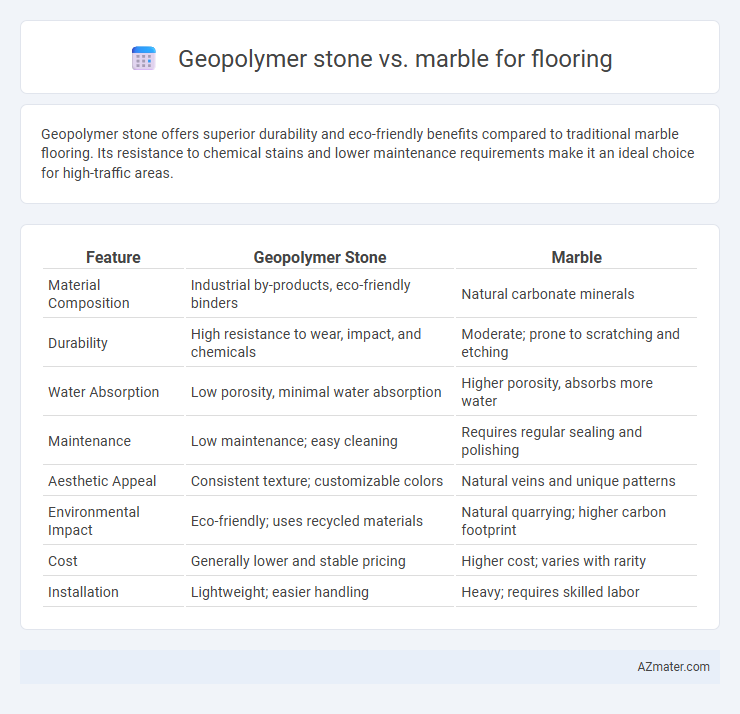Geopolymer stone offers superior durability and eco-friendly benefits compared to traditional marble flooring. Its resistance to chemical stains and lower maintenance requirements make it an ideal choice for high-traffic areas.
Table of Comparison
| Feature | Geopolymer Stone | Marble |
|---|---|---|
| Material Composition | Industrial by-products, eco-friendly binders | Natural carbonate minerals |
| Durability | High resistance to wear, impact, and chemicals | Moderate; prone to scratching and etching |
| Water Absorption | Low porosity, minimal water absorption | Higher porosity, absorbs more water |
| Maintenance | Low maintenance; easy cleaning | Requires regular sealing and polishing |
| Aesthetic Appeal | Consistent texture; customizable colors | Natural veins and unique patterns |
| Environmental Impact | Eco-friendly; uses recycled materials | Natural quarrying; higher carbon footprint |
| Cost | Generally lower and stable pricing | Higher cost; varies with rarity |
| Installation | Lightweight; easier handling | Heavy; requires skilled labor |
Introduction to Geopolymer Stone and Marble Flooring
Geopolymer stone is an innovative flooring material made from industrial byproducts like fly ash and slag, offering high durability and eco-friendly benefits. Marble flooring, a classic natural stone, is prized for its unique veining, luxurious appearance, and long-lasting strength. Both materials provide distinct aesthetic and functional advantages, with geopolymer stone emphasizing sustainability and marble highlighting timeless elegance.
Composition and Manufacturing Process
Geopolymer stone flooring is made from industrial by-products such as fly ash and slag combined with alkaline activators, resulting in a dense, durable material through a chemical curing process at ambient or elevated temperatures. In contrast, marble originates from metamorphosed limestone composed mainly of calcite, quarried as large natural blocks and cut into slabs without extensive chemical treatment. The geopolymer manufacturing process offers enhanced control over material properties and sustainability benefits compared to marble's traditional extraction and finishing methods.
Aesthetic Differences: Appearance and Design Options
Geopolymer stone offers a modern, customizable aesthetic with a wide range of colors, patterns, and textures, allowing for unique, contemporary designs that mimic natural stone or concrete. Marble provides a timeless, classic appearance with natural veining and subtle color variations, creating an elegant and luxurious flooring option. While marble's organic patterns are inherently unique, geopolymer stone allows for greater design flexibility, catering to both traditional and avant-garde interior styles.
Durability and Strength Comparison
Geopolymer stone exhibits superior durability and strength compared to marble, making it highly resistant to cracking and wear in high-traffic areas. Its composition allows for better chemical resistance and higher compressive strength, often exceeding 70 MPa, whereas marble typically has a compressive strength around 50-60 MPa. The enhanced mechanical properties of geopolymer stone contribute to longer-lasting flooring solutions, particularly in industrial and commercial applications where durability is critical.
Environmental Impact and Sustainability
Geopolymer stone flooring offers a significantly lower carbon footprint than traditional marble due to its utilization of industrial by-products like fly ash and slag, reducing waste and limiting reliance on natural stone extraction. The production process of geopolymer stone emits fewer greenhouse gases and consumes less energy, promoting sustainable construction practices. Marble flooring, while aesthetically appealing, involves intensive quarrying that leads to habitat disruption and higher energy consumption, making geopolymer stone a more eco-friendly and sustainable flooring choice.
Cost Comparison: Installation and Maintenance
Geopolymer stone offers a significant cost advantage over marble for flooring, with installation expenses averaging 30-40% lower due to its lighter weight and easier cutting process. Maintenance costs for geopolymer stone are also reduced, as it is highly resistant to stains, cracks, and moisture damage, unlike marble which requires regular sealing and polishing. Overall, choosing geopolymer stone can save up to 50% in long-term floor care and upkeep compared to traditional marble flooring.
Performance: Resistance to Stains, Scratches, and Moisture
Geopolymer stone flooring offers superior resistance to stains, scratches, and moisture compared to traditional marble, making it ideal for high-traffic areas and damp environments. Its dense, non-porous surface prevents moisture penetration and resists chemical damage, ensuring long-lasting durability without frequent sealing. Marble, while aesthetically elegant, is more susceptible to etching, staining, and moisture absorption, requiring regular maintenance to preserve its performance and appearance.
Installation Methods and Considerations
Geopolymer stone flooring offers a faster installation process due to its lightweight nature and modular design, reducing labor costs and minimizing surface preparation compared to traditional marble tiles. While marble requires skilled craftsmanship for cutting and sealing to prevent staining and cracking, geopolymer stone demands precise curing conditions to achieve optimal strength and durability. Considering installation, geopolymer stone is more adaptable to uneven substrates and has better resistance to thermal expansion, making it suitable for diverse indoor and outdoor flooring applications.
Long-term Maintenance and Care
Geopolymer stone flooring offers superior long-term maintenance with its high resistance to stains, scratches, and weathering compared to natural marble, which requires frequent sealing and polishing to prevent surface damage. The inorganic polymer matrix of geopolymer stone minimizes porosity, significantly reducing the likelihood of water absorption and mold growth, thereby lowering maintenance costs over time. In contrast, marble's calcium carbonate composition is more susceptible to acid etching and wear, demanding ongoing specialized care to preserve its aesthetic appeal and structural integrity.
Choosing the Right Material: Geopolymer Stone vs Marble
Geopolymer stone offers exceptional durability, resistance to chemicals, and eco-friendly properties, making it ideal for high-traffic and sustainable flooring projects. Marble provides timeless aesthetics and natural veining but requires regular maintenance and is prone to scratching and staining. Selecting between geopolymer stone and marble depends on balancing durability, maintenance needs, and design preferences for the flooring application.

Infographic: Geopolymer stone vs Marble for Flooring
 azmater.com
azmater.com